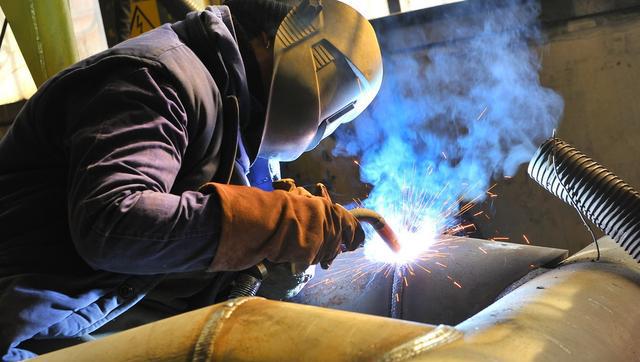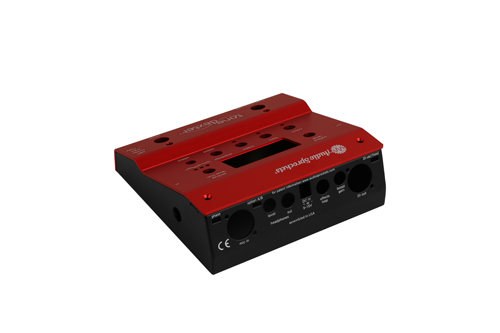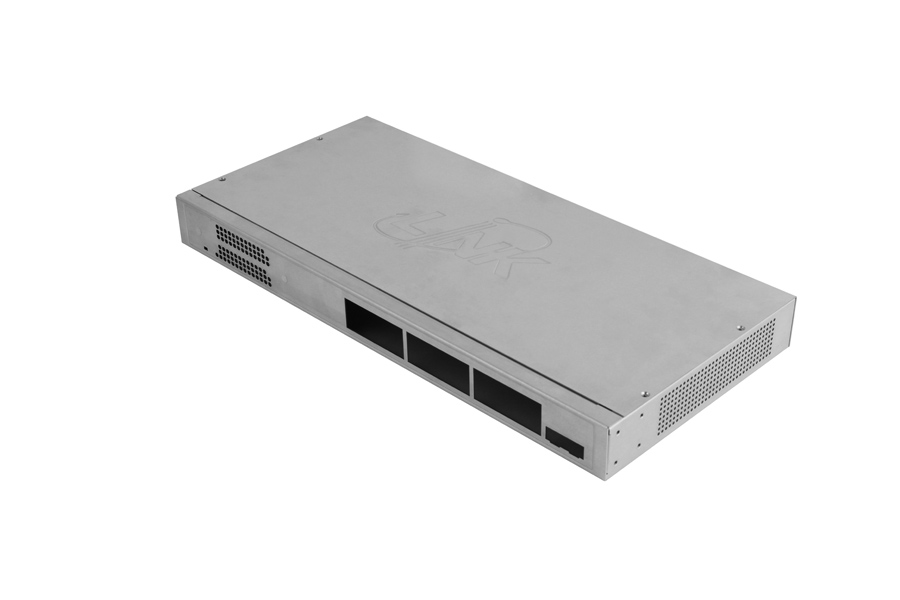Sheet metal welding involves heating and melting sheet metal parts and joining them together to increase their strength or create a single integrated product. This process is widely used in various manufacturing industries, such as automotive, aerospace, construction, and equipment production. Common applications include welding metal frames, cabinets, HVAC systems, and other metal products.
At HSJ Metal Fabrication, we have expertise in different welding techniques, enabling us to make informed decisions when choosing the most suitable welding method for each project to meet our customer's requirements.

| Equipment List | 5-Tig Welders, 300 amp, by Miller. 2-Tig Welder, 250 amp, by Ltech. 2-Tig Welder, 250 amp, Cobramatic for aluminum. 2-Tig Welders, 330 amp, by Miller. 2-Airco wire feed. 2-Welder Airco. 2-TRW stud welding machine. 5-Portable welder | 5-Tig Welder, 300 amp, by Airco. 2 Miller heliarc welder. 2-Tig Welder, 250 amp, Miller Syncrowave 2-Mig Welder, Miller, 300 Amp. 2-Miller CP300, wire feed. 2-Acme spot welder, 30" arm, water cooled, air timer. 5-Gas powered field welder, Miller |
| Industry Area | Medical Defense Packaging Building Materials & Construction Electrical Equipment & Electronics Commercial Display | Oil & Gas Transportation Heating & Cooling Engineering Aerospace Industrial Equipment |
| Size(mm) | Grade1 | Grade2 | Grade3 | Grade4 | Grade5 | Gerneral Angle |
| 0-30 | ±0.1 | ±0.2 | ±0.3 | ±0.4 | ±1 | 90degree, ±1 |
| 31-120 | ±0.15 | ±0.25 | ±0.4 | ±0.7 | ±2 | |
| 121-250 | ±0.2 | ±0.3 | ±0.6 | ±1 | ±2 | / |
| 251-500 | ±0.3 | ±0.5 | ±1 | ±1.8 | ±2 | |
| Above 500 | ±0.5 | ±0.8 | ±1.5 | ±3 | ±3 |
Aluminum (2A21/3003/5052/5083/6061/6082 /8011)
Carbon Steels(Q235,SPHC ,SPCC,SPCD ,SPCE ,ST,ST12,ST13,ST14,ST15,ST14-T )
Stainless Steel ( 304,304L ,312 ,316,317,321,347,904L,440,17-4ph,430 etc.)
Copper (C1020、C1100、C2100,2200,2300,2400)
Brass ( H62、H65、H68、H70、H80、H90、C2600、C2680、C2700、C5210、C5191、 C51000、QBe2.0、C1100、T2)
Other Non-Ferrous Alloys
| Material | Features | Thickness(mm) |
| Electro-galvanised steel (SECC) | Fingerprint-resistant, with excellent corrosion resistance and good paintability, while maintaining the processability of cold rolled sheet | 0.8, 1.0, 1.2, 1.5, 2.0 |
| Cold rolled sheet (SPCC) | No rust resistance, surface plating or baking paint is required. | 0.8, 1.0, 1.2, 1.5, 2.0, 3.0 |
| Galvanised Steel Sheet (SGLD) | A multi-phase alloy containing aluminium and zinc rich material with beautiful appearance, scratch resistance, corrosion resistance and much higher capacity than SGCC. | 0.8, 1.0, 1.2, 1.5, 2.0, 3.0 |
| Aluminium sheet (AL) | Lower strength, excellent forming properties, good weldability and corrosion resistance, and good heat dissipation capability. | 0.8, 1.0, 1.2, 1.5, 2.0, 2.5, 3.0, 4.0, 5.0 |
| Hot-dip galvanized steel plate (SGCC | Beautiful appearance, there are two kinds of zinc flowers, small zinc flowers, it is difficult to see the zinc flowers; large zinc flowers can obviously see the kind of hexagonal flower blocks. It has corrosion resistance, paintability, formability, and spot welding. | 0.8, 1.0, 1.2, 1.5, 2.0, 3.0 |

Save metal materials and reduce structural weight. Simplify processing and installation procedures and improve production efficiency.

The structural strength is high, and the joint sealing is good; it provides greater flexibility for structural design. The welding process is easy to realize mechanization and automation.
HSJ Metal Fabrication Co., Ltd is a specialized sheet metal fabrication company located in Shenzhen, China. We offer industrial and commercial fabrication services, including OEM, ODM, and customized solutions for size, color, surface treatment, logo, assembly, or packing. Since 2015, we have been committed to providing dependable and excellent customer service for every project we undertake.
Qualified Sheet Metal & Welding has been serving small and large clients for over 8 years. We have successfully completed thousands of projects for commercial, industrial, pharmaceutical, and aerospace clients from China and abroad. Our commitment to innovation and hard work has earned us a reputation as a reliable and experienced sheet metal fabrication company.
At HSJ Metal Fabrication, we use the highest-quality materials, the best cutting-edge technologies, and the most efficient welding processes to ensure the accuracy and precision of our work. Our 20 years experienced engineer and professional service teams have successfully completed high-level customer requirements. We offer customized solutions for each client and ensure the most accurate and precise workmanship available in this field.
We are affiliated with the Associated Builders & Contractors Association and are committed to providing the broadest range of sheet metal and welding services to the commercial, industrial, and pharmaceutical industries.
Contact us now for all your sheet metal needs!
HSJ sheet metal welding comes with various types of sheet metal welding, including gas tungsten arc welding (GTAW), gas metal arc welding (GMAW), and resistance welding.
Typical types of sheet metal welding processes including, MIG welding, TIG welding, resistance welding, projection welding, robotic MIG and TIG welding, and laser welding on various metallic and aluminum alloy surfaces as well as on stainless steel and iron.
MIG welding
MIG welding, also called MAG welding, is a continuous wire welding process where a shielding gas ensures firing bath protection. MIG or MAG welding is used where high productivity and high flexibility of use are required. While MIG welding requires the use of inert gas, MAG welding is carried out through an active gas. MIG welding can be also performed on thin metal, such as thin steel or aluminum.
TIG welding
TIG welding is one of the most popular welding methods since it provides high-quality components. Especially indicated to weld thin parts, it can be used for both continuous and spot welding.
Resistance welding
Resistance welding is a metal fusion welding technique where the material is heated by electrical resistance. Generally used to weld iron and steel, resistance welding guarantees high-quality standards on welded components while ensuring time and cost savings. If you want to learn more about resistance welding, we will explain everything to you.
Projection welding
Projection welding requires studs to be placed on the metals to be welded. During the metal welding process, the welding current is focused on the stud that heats to obtain complex welds, with final results that ensure excellent quality at low costs. Basically, projection welding is a type of resistance welding that uses projection.
Robotic TIG MIG MAG welding
Robotic welding is performed by programmable industrial robots. Mainly used in situations that require repeated welding, it guarantees repeated precision which is hard to achieve with manual welding. Greater precision and higher productivity are the main advantages of robotic welding.
Laser welding
Laser welding allows metals and metallic alloys to be welded, creating a thin and deep weld, with reduced heat deformations thanks to the reduced heat, even on materials that could not otherwise be welded. Precision, cleanness, minimal heat input, and fast manufacturing are just a few of the advantages of laser welding.
Welding metals: the metals that we process in Minifaber
The mentioned welding processes apply to a wide range of metals and sheet metal components that can be welded to create semi-finished and finished products. Through these processes, HSJ can provide welding of iron, aluminum, stainless steel, and copper.
Iron welding
Iron welding is widely employed in several industrial sectors. Thanks to a cutting-edge machinery and the extensive know-how raised through the years, Minifaber can provide iron welding services with the highest cleanness and precision. There are 5 different ways to carry out iron welding: HSJ can help you choose the right one!
Aluminum welding
Renowned for its ductility, lightness, and oxidation resistance, aluminum is employed in every sector in which these qualities are required, such as the aerospace sector and the transport sector. HSJ is focused on various types of aluminum welding: aluminum MIG welding, aluminum tig welding, and other welding processes to manufacture aluminum according to the desired output.
Stainless steel welding
Stainless steel is a special steel alloy that boasts important qualities such as rust resistance, corrosion resistance and high hygiene standards. For this reason, stainless steel is widely employed in the food industry. HSJ provides stainless steel welding services for any specific requirements and offers three different services of stainless steel welding.
Copper welding
Copper is employed in the electrical and electromechanical sectors for its high conductivity and ductility. Copper welding is among the services provided by Minifaber for national and international customers.



Welding thin sheet metal demands a delicate touch and specific methods compared to thicker materials. Thin metals are more prone to warping and burn-through, making it essential to employ the right equipment and techniques. Both TIG and MIG welding are suitable for welding thin metal sheets, but when working with extremely thin stainless steel or aluminum, the TIG method takes precedence due to its exceptional heat input control.
The thinnest sheet metal that can be welded depends on several factors, including the welding method, the skill of the welder, and the specific application. Generally, welding very thin sheet metal can be challenging because of the risk of distortion, burn-through, or warping. However, experienced welders can work with extremely thin materials.
TIG (Tungsten Inert Gas) welding is often preferred for welding thin sheet metal because it provides more precise control and lower heat input compared to other welding methods like MIG (Metal Inert Gas) welding. TIG welding can be used for sheet metal as thin as 0.010 inches (0.25 mm) and sometimes even thinner.
With advanced welding techniques and specialized equipment, some welders can work with materials as thin as 0.005 inches (0.13 mm) using TIG welding. However, it's essential to keep in mind that handling such thin materials requires a high level of skill, experience, and attention to avoid damaging the metal or producing weak welds. Proper preparation, fit-up, and welding techniques are crucial when working with very thin sheet metal to achieve successful and durable welds.
HSJ is a reputable sheet metal welding manufacturer based in China. With a team of highly skilled and experienced welders, we take pride in delivering top-notch sheet metal welding services to our valued customers. If you require high-quality sheet metal welding solutions, do not hesitate to reach out to us. We are here to cater to your needs and ensure your satisfaction with our services.
The strength of a weld is not inherently determined by the welding process itself (MIG, TIG, or Arc), but rather by the quality of the weld and the skill of the welder. Each welding process has its strengths and is suited for different applications. HSJ is an expert of welding sheet metal fabrication. We knows clearly about different types of welding methods. Let's briefly compare them:
MIG (Metal Inert Gas) Welding:
MIG welding is known for its ease of use and high welding speed, making it suitable for various applications and thicker materials.
The weld strength depends on the skill of the welder, the correct selection of welding parameters, and the preparation of the joint.
In some cases, MIG welds might be considered less aesthetically appealing due to potential spatter and a larger bead profile.
TIG (Tungsten Inert Gas) Welding:
TIG welding provides excellent control over the welding process, making it ideal for welding thin materials and critical welds.
With proper technique, TIG welds can be very strong, and they are often known for their high-quality and clean appearance.
TIG welding requires a higher level of skill and is generally slower than MIG welding.
Arc Welding (Shielded Metal Arc Welding or SMAW):
Arc welding, commonly referred to as stick welding, is a versatile process suitable for various applications and outdoor use.
It can produce strong welds, especially in heavy and structural applications.
However, it may not be as precise or visually appealing as TIG welding for certain applications.
In summary, the strength of a weld depends more on the welder's skill, the proper choice of welding process for the specific application, and the appropriate welding parameters rather than the welding process itself. All three processes (MIG, TIG, and Arc) are capable of producing strong welds when performed correctly. Experienced welders can achieve excellent results with any of these processes, depending on the requirements of the project.